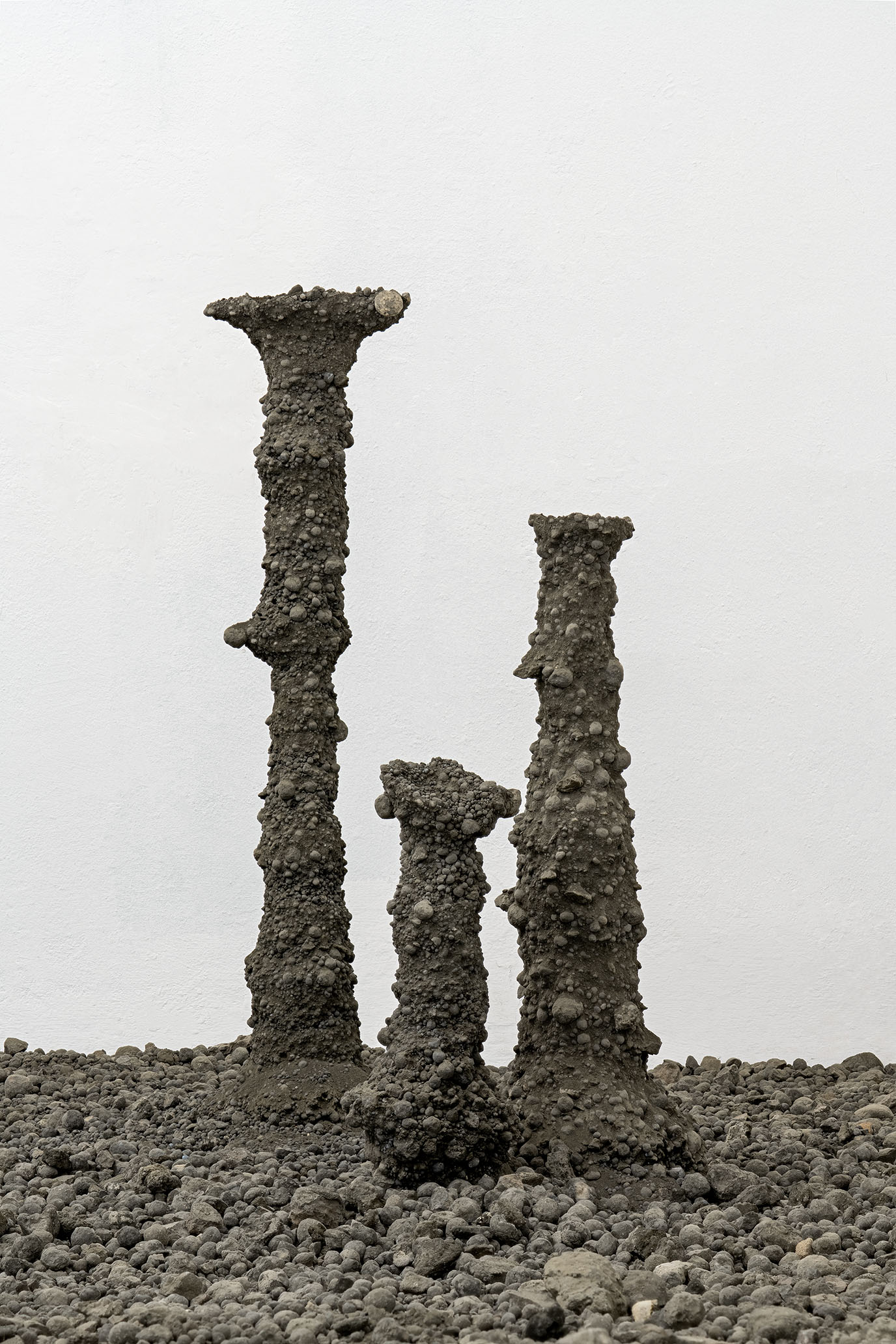Synthetic Geologies

Lithic Remnants Installation. Photo by Simon Veres, 2025.
Synthetic Geologies explores cement as a medium in flux—one shaped by the compression of deep time into industrial time, where stone is extracted, fragmented, calcined, and recombined into synthetic rock formations that mimic yet diverge from their geological origins. Cement is not merely a material but a process, a site where the natural and the manufactured collapse into one another, unsettling any clear boundary between geology and industry.
At what point does a material cease to be "natural" and become "synthetic"? Cement, as a reconstituted form of limestone and clay, embodies this ontological instability, existing simultaneously as a geological residue and an artifact of human engineering. By recontextualizing cement, the exhibition disrupts its conventional anonymity, revealing it not as a passive binder of aggregates but as an active site of material memory, where its transformations can be read, traced, and made tangible.
Through sculptural interventions and material displacements, the works navigate the entanglement of human and geological forces. Some forms appear as if excavated from an unknown past, while others anticipate a fossil record yet to come, a moment in which synthetic and natural sediments become indistinguishable. If the built world functions as an artificial stratigraphy, what does it mean to manufacture stone? And if concrete, once set, is destined to fracture and erode, how does this cycle of making and unmaking define the geologies we now construct?

Lithic Remnants Installation. Photo by Simon Veres, 2025.

Lithic Remnants Installation. Photo by Simon Veres, 2025.


Lithic Remnants Installation. Photo by Simon Veres, 2025.




Cement
clinker, the granular residue of high-temperature calcination, is itself an
intermediary state—neither raw nor fully realized, suspended between
disintegration and recomposition. Its production resembles the earth’s own
metamorphic processes, where heat and pressure induce irreversible material
shifts, yet here, the transformation is intentional, directed, and
infrastructural.
The sculptural objects, formed through a process inspired by
natural cementation—the slow lithification of sediment through mineral
binding—allow particles to settle and bond in unpredictable ways. Some appear
as if unearthed from an unknown past, while others suggest remnants of a future
fossil record, fragments of an era in which the geological and the manufactured
have become indistinguishable.

Heat Shield Curtain. Photo by Simon Veres, 2025.
 Rotary Lava Video Installation. Photo by Simon Veres, 2025.
Rotary Lava Video Installation. Photo by Simon Veres, 2025.
Inside the rotary kiln, limestone, clay, and other raw materials undergo
a controlled sequence of chemical transformations. Crushed and blended, they
move gradually through the rotating kiln, passing through distinct temperature
zones where their composition continuously changes.
At around 100°C, any remaining moisture evaporates. As the temperature
rises to 400–600°C, clay minerals break down, and certain compounds in the mix
begin to decompose. Between 650 and 900°C, silica starts reacting with calcium
to form early-stage mineral phases. From 900 to 1,050°C, the remaining
limestone fully decomposes into reactive lime, releasing CO₂.
At higher temperatures of 1,300–1,450°C, silicates, aluminates, and
ferrites fuse and form new mineral structures. The material partially melts, creating
molten nodules that resemble volcanic lava, before cooling and solidifying into
the cement clinker. This process replicates igneous rock formation but with
controlled precision, turning sedimentary minerals into an engineered stone.
The video installation captures this transformation through a direct
view into the kiln’s interior, where molten clinker rotates continuously under
intense heat. Filmed through the small observation windows, the footage reveals
the glowing mass of semi-molten material as it moves through the kiln, its
surface shifting in texture and color as it undergoes chemical change.

Shallow Sea Installation. Photo by Simon Veres, 2025.




Limestone,
the primary raw material for cement production, is a sedimentary rock formed
over millions of years through the accumulation and compaction of marine
organisms such as corals, shells, and microscopic plankton. As these
calcium-rich remains settled on ancient sea floors, they were gradually buried
under layers of sediment. Over time, pressure and chemical processes caused the
loose sediments to lithify, forming solid rock primarily composed of calcium
carbonate (CaCO₃).
In cement
production, limestone is extracted from quarries through drilling and
controlled blasting, then transported for processing. The large fragments are
crushed in multiple stages to achieve the required size for further blending
with other raw materials. This process maintains a consistent composition
before the material enters the kiln for high-temperature transformation into
clinker.
The
installation includes limestone sourced from the Mannersdorf quarry near
Vienna, a site with deposits dating back to the Late Jurassic and Early
Cretaceous periods. The extracted stone contains visible shell fossils and
crystallized calcite structures, remnants of its marine origins. These
geological traces can be seen in the stones lying on the bed of steel balls
used for grinding, where limestone is crushed into fine particles before being
incorporated into cement production.
Project info
2025 - Vienna - AUT.
Exhibited in MAGAZIN. Rembrandtstraße 14/1A, 1020 Vienna, Austria.
Solo exhibition by Studio Eidola. Supported by MAGAZIN. Space for contemporary architecture.
Thank you very much MAGAZIN team: Matthias, Jerome, Sara, Oemer and Florian.
Many thanks to Holcim Switzerland and Holcim Austria for the material support.
Contact us for more information.